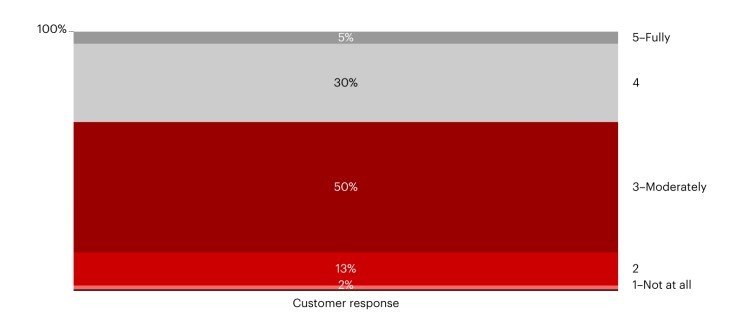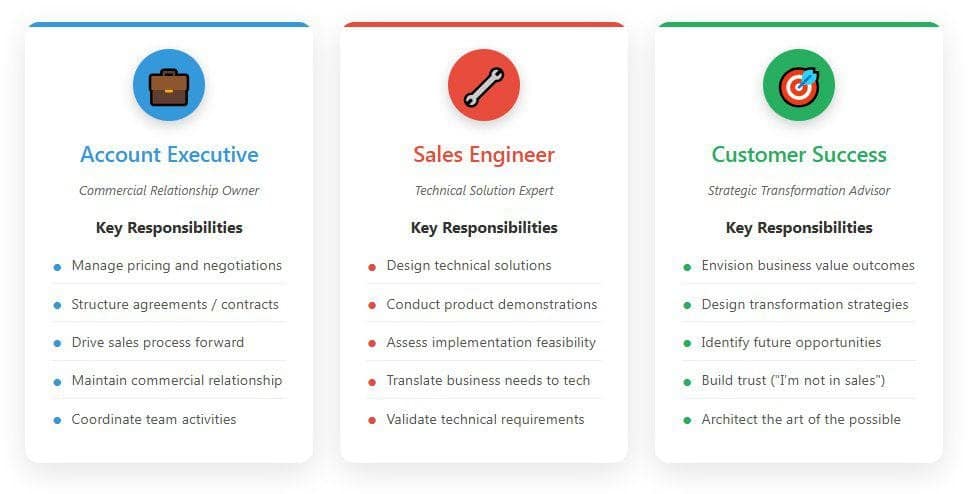Don’t Turn CSMs into Salespeople
There’s a growing push to reframe Customer Success as a revenue function. Lately, industry leaders like David Karp, Alex Raymond, Bob Mathers, and Angeline Gavino have each offered strong arguments for why CS should be tied directly to revenue performance.
I realize I’m often on my own soapbox, but my bold statement is this: I believe tying Customer Success directly to revenue corrupts its purpose, distorts its relationships, and ultimately weakens its impact. And I’ll challenge anyone to a model-off to prove it.
David Karp recently posted:
“By 2028, the majority of today’s CSM activities will be replaced by AI or absorbed into a revenue-driving function.”
I genuinely enjoy David’s writing, and his perspective. Follow him, he’s awesome! And He also does the important part, “Your turn. Challenge it. Rip it apart. Or build on it.”
So I will! 🙂
This rationale that many experts are talking about is popular because most organizations default to a business-centric mindset. It’s easier to chase forecasts than to earn trust. And no, I don’t believe you can balance both equally. You’re either customer-centric or you’re not. There is no tie. One always leads.
My point of view on David’s quote requires a slight edit:
“By 2028, the majority of today’s [bad] CSM activities will be replaced by AI or absorbed into revenue-driving functions [by companies that no longer care about their customers.]”
Yes, I believe there’s a long list of CSM activities happening today that shouldn’t exist in the first place. Bad activities.
Take QBRs, for example, entire teams spend weeks preparing decks, pulling data, formatting slides, and now… using AI to automate the process. QBR content. QBR analysis. QBR KPIs. All auto-generated. But for what?
In a truly human, customer-centric organization, the question isn’t how to make QBRs more efficient. It’s whether they should exist at all. (Here’s why I think they shouldn’t.)
The moment we start using AI to automate activities that should have never been required in the first place, we’ve already generated churn.
But let me be clear, there’s a fundamental difference between influencing revenue and being responsible for it. (I explore this more here.)
Jason McAllister asked me a sharp question the other day:
“If a CSM can identify future opportunities, why can’t they continue that process? Why hand it off to sales?”
It’s a fair question. And the answer reveals the flaw in the desire to bring these roles together.
CSMs should absolutely demonstrate business impact. That’s part of the role.
However, just because you can identify an opportunity doesn’t mean you’re the right person to formalize the deal. CSMs drive strategy, uncover value, and build relationships. Sales navigates procurement, legal, pricing, and negotiations.
Both roles matter, but they’re not interchangeable.
Tying quotas or AI to CS might look efficient in a business spreadsheet. But in reality, it fails. It breaks trust, dilutes focus, and damages the customer relationship.
Here’s why.
1. Revenue Pressure Breaks Customer Trust
When a CSM becomes a seller, the customer sees it instantly. Strategic conversations get guarded. Transparency dries up. And instead of solving problems together, everything starts to feel transactional.
It’s no surprise: trust and sales pressure don’t mix.
The number of meetings I’ve been in or have asked to be in “without sales” is staggering.
MIT Sloan found that the level of trust between a company and its customers directly impacts both purchasing frequency and the value customers place on it. When customers believe their CSM is aligned with their goals, they share more, engage more, and grow more. When they sense a pitch coming, they disengage.
Be honest with yourself. You, yourself, in your own sales engagements. You do recoil to.
Bain found that even as CS investment grows, net revenue retention is declining in 75% of software firms. Why? Because we’ve confused being “proactive” with being “predictably pushy.” You can’t build trust when your primary objective is to extract value instead of create it.
When asked “are your post-sales needs currently being met?” about 65% of customers feel their needs are only being moderately addressed or worse.

“It turns out a huge disconnect exists between how customers want to be served and what vendors think they need.”
Tip: Protect the “trusted” advisory role. Keep CSMs focused on strategic value, innovative outcomes, and long term advocacy. Let Sales handle formal negotiations and deal closure.
2. AI Isn’t the Future of CS, Humans Are
Customer Success should be customer-centric. That starts with being human first, not AI first.
I’ve said this before: when CSMs start leaning on AI to summarize conversations, manage their portfolio, or predict churn, what they’re doing is avoiding the job. AI becomes a shield. A crutch. A way to stay busy instead of being present.
If you’re building a CS team around “agent-to-agent” communication, you’ve already forgotten why CS exists. It’s not automation to automation. It’s human to human.
You don’t need AI to predict churn if you’re in the room helping your customer build their roadmap. You don’t need AI to run customer insights if you’re speaking with them weekly. Every time a CSM avoids time with a customer, they lose the one thing CS is built on: connection.
Tip: Use AI to augment, not replace. Let automation handle admin work, so CSMs can spend more time face-to-face with customers building strategy and solving problems.
3. Sales and CS Are Different Tools for Different Jobs
I can use a screwdriver to drive a nail into wood. But that’s not what it’s built for.
Sales and CS operate on entirely different mechanics. Sales is designed for entry, negotiation, objection handling, and closing. CS is built for a big picture transformation, enabling relationships, long-term strategy, and value outcomes all to serve the art of the possible.
There are a few core traits I expect from everyone regardless of role. At the top of that list is a customer-first mindset. Every employee should understand what it means to be customer-centric. That’s foundational.
But beyond that, the skills start to diverge.
When companies try to merge the two, they don’t create a new hybrid role. They break both. Instead of specialization, they get dilution. Instead of focusing, they get confused.
It’s about function. You don’t get better outcomes by cross-wiring the roles. You get more burnout, misaligned incentives, and customers who feel like every check-in is just a disguised sales call.
Instead of merging complex skillsets into a singular role, bring CS into the process earlier. Integrate CSMs into pre-sales to drive strategic thinking sooner, remove onboarding constraints, and reduce churn.
This approach also creates a psychologically safe and unified “Growth Squad” for both the customer and the team.

Tip: Invest in specialization. Build distinct paths for Sales, Tech, and CS. Cross-functional alignment is critical, but the responsibilities must stay focused.
4. Quotas vs. Impact: Know the Difference
There’s a critical difference between carrying a revenue quota and driving revenue impact.
I’m all for tracking the influence CS has on retention, expansion, and product growth. But making that influence conditional on a closed deal breaks the role. It shifts the energy from enablement to extraction.
I know this, because I have influenced over $2 billion in revenue without closing a single deal.
A CSM who’s empowered to drive outcomes will surface expansion naturally through customer success plans, strategic planning sessions, and deep adoption efforts. However, a CSM who is accountable for closing revenue will rush those conversations, push for deals prematurely, and risk damaging the relationship.
Tip: Track value influence, not revenue ownership. Use success metrics like product adoption, expansion readiness, and strategic plan alignment as your CS north star.
5. Customer Advocacy Is the Real Growth Engine
The loudest voice in your go-to-market strategy shouldn’t be your pitch. It should be your customer.
Word of mouth drives purchase decisions. Research shows that 90% of B2B enterprise software buyers place more trust in peer reviews than they do in traditional marketing messages. Referrals close faster, cost less, and retain longer. But referrals don’t come from quota-bearing relationships. They come from partnerships built on trust and results.
One of the most effective shifts I’ve made in Customer Success organizations is aligning CS more closely with Marketing than with Sales. In this model, CS becomes the engine behind success stories, not just the keeper of retention. When CSMs highlight what customers are achieving and Marketing turns those stories into content, campaigns, or even customer podcasts, you build momentum. You build credibility.
In this approach, Customer Success isn’t about closing deals. It’s about creating advocates and expanding the pipeline. That’s a different motion, and a much more sustainable one.
Customer advocacy doesn’t happen in a world where every CSM call comes with a forecast update. It occurs when CSMs have the freedom to make the customer the hero of the story, not the target of a number.
Tip: Turn outcomes into stories. Empower CSMs to develop champions, gather testimonials, and surface authentic success narratives that drive organic growth.
Don’t Break What Works
The real danger isn’t AI or economic pressure. It’s short-term thinking.
Customer Success isn’t about protecting goodwill or babysitting accounts. It’s a strategic function that enables retention, expansion, and long-term growth through trust, opportunities, and advocacy.
If we continue to treat it simply as a way to make money, we’ll lose the best part of the business: the human element.
Let Sales sell. Let CS drive value. Let AI support, but not replace, either of these. And let your customers lead the way.
That’s a future worth building.
If you find this content valuable, please share it with your network.
Chris Hood is a customer-centric leader and author of the #1 Amazon Best Sellers “Infailible” and “Customer Transformation,” and has been recognized as one of the Top 40 Global Gurus for Customer Experience.
To learn more about building customer-centric organizations or improving your customer experience, please contact Chris at chrishood.com/contact.